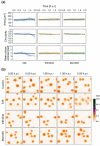Investigating Morphological Changes of T-lymphocytes after Exposure with Bacterial Determinants for Early Detection of Septic Conditions
- PMID: 35208846
- PMCID: PMC8879819
- DOI: 10.3390/microorganisms10020391
Investigating Morphological Changes of T-lymphocytes after Exposure with Bacterial Determinants for Early Detection of Septic Conditions
Abstract
Sepsis is a leading cause of morbidity and mortality, annually affecting millions of people worldwide. Immediate treatment initiation is crucial to improve the outcome but despite great progress, early identification of septic patients remains a challenge. Recently, white blood cell morphology was proposed as a new biomarker for sepsis diagnosis. In this proof-of-concept study, we aimed to investigate the effect of different bacteria and their determinants on T-lymphocytes by digital holographic microscopy (DHM). We hypothesize that species- and strain-specific morphological changes occur, which may offer a new approach for early sepsis diagnosis and identification of the causative agent. Jurkat cells as a model system were exposed to different S. aureus or E. coli strains either using sterile determinants or living bacteria. Time-lapse DHM was applied to analyze cellular morphological changes. There were not only living bacteria but also membrane vesicles and sterile culture supernatant-induced changes of cell area, circularity, and mean phase contrast. Interestingly, different cellular responses occurred depending on both the species and strain of the causative bacteria. Our findings suggest that investigation of T-lymphocyte morphology might provide a promising tool for the early identification of bacterial infections and possibly discrimination between different causative agents. Distinguishing gram-positive from gram-negative infection would already offer a great benefit for the proper administration of antibiotics.
Keywords: T-lymphocyte; cell morphology; digital holographic microscopy; sepsis.
Conflict of interest statement
The authors declare no conflict of interest.
Figures






References
-
- Singer M., Deutschman C.S., Seymour C., Shankar-Hari M., Annane D., Bauer M., Bellomo R., Bernard G.R., Chiche J.D., Coopersmith C.M., et al. The Third International Consensus Definitions for Sepsis and Septic Shock (Sepsis-3) JAMA. 2016;315:801–810. doi: 10.1001/jama.2016.0287. - DOI - PMC - PubMed
-
- Rudd K.E., Johnson S.C., Agesa K.M., Shackelford K.A., Tsoi D., Kievlan D.R., Colombara D.V., Ikuta K.S., Kissoon N., Finfer S., et al. Global, Regional, and National Sepsis Incidence and Mortality, 1990–2017: Analysis for the Global Burden of Disease Study. Lancet. 2020;395:200–211. doi: 10.1016/S0140-6736(19)32989-7. - DOI - PMC - PubMed
-
- Ferrer R., Martin-Loeches I., Phillips G., Osborn T.M., Townsend S., Dellinger R.P., Artigas A., Schorr C., Levy M.M. Empiric Antibiotic Treatment Reduces Mortality in Severe Sepsis and Septic Shock From the First Hour. Crit. Care Med. 2014;42:1749–1755. doi: 10.1097/CCM.0000000000000330. - DOI - PubMed
Grants and funding
LinkOut - more resources
Full Text Sources
Molecular Biology Databases

